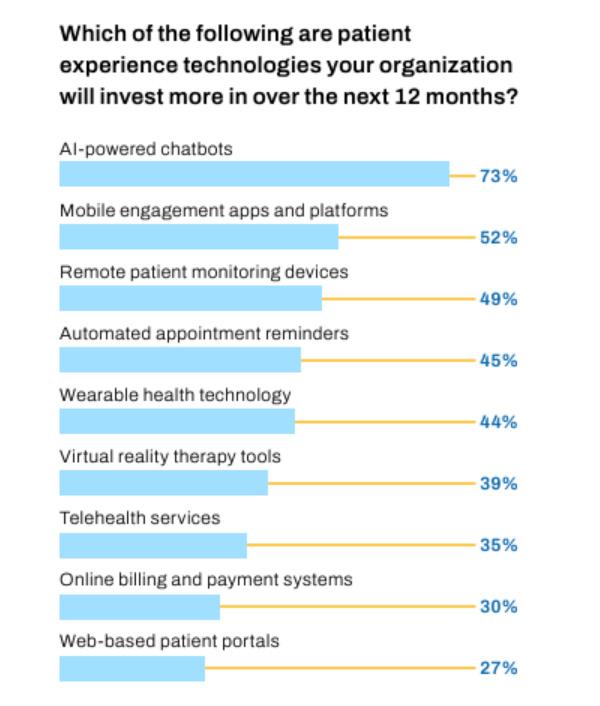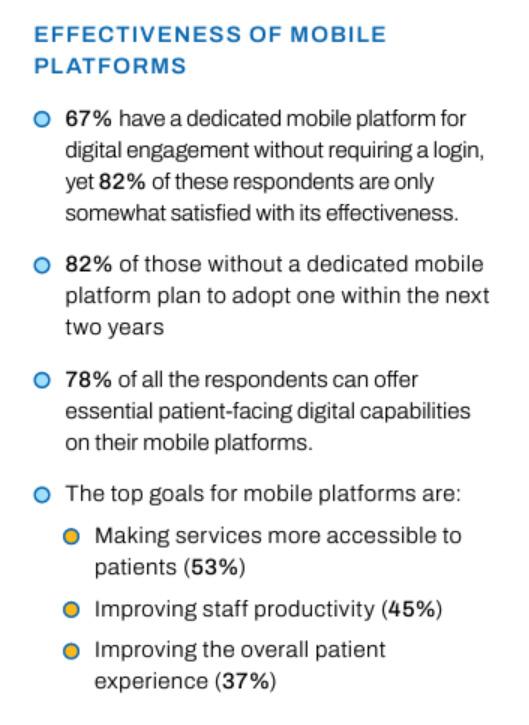
Healthcare organizations are facing tight margins and workforce challenges while striving to deliver efficient patient-centered care. Leaders are increasingly turning to innovative technologies to improve patient experience.
Healthcare organizations are showing a growing commitment to enhancing the patient experience by increasing their investment in digital tools, according to an October 15 survey conducted by Gozio Health, a mobile engagement platform.
Survey results reveal that 78% of respondents expect their budgets for patient experience technologies to grow in the next year. These findings underscore the importance of digital solutions in modern healthcare and indicate that leaders are prioritizing spending to address gaps and improve patient engagement.
Read the Full Report: “THE DIGITIZATION PATIENT JOURNEY: How Healthcare Providers Are Enhancing Access, Streamlining Services, and Improving Outcomes with Digital Tools”
The survey, which involved 100 healthcare leaders, explored their views on digital transformation, efforts to improve patient experience through technology, and the challenges in optimizing care processes.
Sign up to get the latest industry news and offers right in your inbox

Source: Gozio Health
The top two investments include AI-powered chatbots (73%) and mobile engagement apps and platforms (52%). Both of these options offer advantages as well as challenges, and patient perception toward these tech offerings varies.
This blog addresses these key survey results and patient perception and also provides actionable insights for healthcare administrators and clinicians.
Patient Perspectives on AI Chatbots in Healthcare: Insights for Healthcare Administrators and Clinicians
Patients’ feelings about AI chatbots in healthcare vary based on factors like the context of use, chatbot quality, and individual preferences. Understanding these reactions can help administrators and clinicians effectively integrate AI tools while maintaining patient satisfaction.
Here are a few key points—positive and negative—to consider:
Positive Reactions
- Convenience and Accessibility: Patients value the 24/7 availability of AI chatbots, enabling them to access information or support outside of traditional office hours. These tools are particularly effective for handling common inquiries, scheduling appointments, and providing medication reminders, reducing the need for administrative staff intervention.
- Quick Responses: Immediate responses to non-emergency questions minimize patient wait times, enhancing the overall care experience.
- Non-Judgmental Interaction: Chatbots can serve as a safe space for patients to discuss sensitive topics without fear of judgment, encouraging open communication about their health concerns.
- Support for Chronic Conditions: Patients managing chronic illnesses often benefit from chatbots that assist with symptom tracking, lifestyle guidance, and routine check-ins, offering consistent support between visits.
Negative Reactions
- Impersonal Communication: The lack of empathy and human touch in chatbot interactions is a common concern, especially in emotionally charged situations. Patients may feel frustrated if their issues are not fully understood or appropriately addressed.
- Trust Issues: Patients worry about the accuracy of medical advice from chatbots, particularly for complex conditions or critical health issues. Privacy and data security concerns can also undermine trust in AI solutions, especially if patients feel their information is at risk.
- Limitations in Understanding: Chatbots often struggle to navigate nuanced or multi-faceted health questions, which can lead to dissatisfaction when patients feel their needs are unmet.
- Fear of Replacing Human Care: Patients may perceive increased reliance on AI chatbots as a threat to meaningful human interaction with healthcare providers, potentially diminishing the quality of care.
These perceptions are impacted by additional factors. Some of the more notable influences include Transparency, Effectiveness, Use Case, and Demographics. Here’s what this means—and how to address it:
- Transparency: Clearly communicate the chatbot’s role, capabilities, and limitations. Patients are more receptive when they know when and how a human provider will intervene if needed.
- Effectiveness: High-quality, well-designed chatbots that deliver accurate and helpful information foster trust and satisfaction. Prioritize regular updates and testing to maintain reliability.
- Use Case: Patients are more accepting of chatbots for administrative tasks (such as appointment scheduling) and supplemental roles (reminders or symptom tracking) rather than for diagnoses or emotionally sensitive issues.
- Demographics: Younger, tech-savvy patients are more open to adopting AI tools, whereas older patients or those less familiar with technology may require additional support and reassurance.
When it comes to patient feelings and perceptions, there will always be elements beyond your control. However, here are some suggestions on how to handle these common concerns in order to integrate AI in a way that supports patient-centered care.
Actionable Strategies for Healthcare Teams
- Balance AI with Human Care: Use chatbots to complement, not replace, human interaction. Ensure patients can easily escalate to live support for more complex or emotional concerns.
- Emphasize Security: Invest in robust cybersecurity measures and communicate these clearly to patients to address privacy concerns.
- Educate Patients and Staff: Provide clear guidelines on the chatbot’s functionality and limitations. Educate staff to seamlessly integrate AI tools into patient care.
- Monitor and Adapt: Regularly gather patient feedback to refine the chatbot experience and address areas of dissatisfaction.
By carefully implementing and managing AI chatbots, healthcare administrators and clinicians can enhance efficiency, improve patient satisfaction, and deliver higher-quality care without sacrificing the human connection that is critical to effective healthcare.
How Healthcare Transitions to Mobile Platforms Can Affect Patients
Besides AI chatbots, a majority percentage of the healthcare leaders surveyed indicated they planned to invest in mobile apps and platforms. Their support of this transition and reasons for implementation is based on several factors, all of which center on improving the patient experience.

Source: Gozio Health
How Patients Feel About Mobile Platforms in Healthcare
As with AI Chatbots, there are both positive and negative patient responses and ways for administrators to increase the former while mitigating the latter.
Positive Reactions
- Convenience and Accessibility: Patients value the ability to manage healthcare tasks—like scheduling, accessing test results, and requesting medication refills—via mobile platforms. This is especially appreciated by those with busy schedules or limited mobility.
- Enhanced Communication: Secure messaging, telehealth options, and notifications keep patients informed and connected with their care teams, fostering a sense of partnership in managing health.
- Time-Saving Tools: Mobile check-ins, digital forms, and streamlined billing processes save time for patients and reduce administrative burdens for staff, contributing to a smoother overall experience.
- Transparency and Engagement: Easy access to medical records and personalized health data empowers patients to take an active role in their care, enhancing satisfaction and trust.
The challenges and concerns associated with mobile platforms are similar to those related to AI in general and chatbots specifically.
Negative Reactions
- Privacy and Security Risks: Patients worry about data breaches and how their personal health information is stored and shared. Platforms that fail to meet high-security standards may erode trust.
- Accessibility and Usability Barriers: Not all patients are tech-savvy or have access to modern devices and reliable internet. Complex or glitchy interfaces can alienate users, especially older patients.
- Impersonal Interactions: Some patients fear mobile platforms might replace valuable face-to-face communication, leading to a less personalized care experience.
- Incomplete Issue Resolution: Patients may become frustrated if mobile platforms can’t address complex needs or if provider responses are delayed within the system.
Actionable Strategies for Healthcare Administrators
The following strategies can be used across most AI integrations, and each action step is intended to foster the relationship between patient and provider.
Medical facilities must ensure platforms are HIPAA-compliant and employ robust encryption to protect sensitive patient information. Then, clearly communicate security measures to patients to build trust.
Tech is great if it’s also user-friendly. Navigating healthcare systems, insurance protocols, and treatment plans is challenging enough. Patients don’t want to add another hurdle to their path. So, choose platforms with intuitive interfaces and straightforward navigation. Offer multilingual support to cater to diverse patient populations. Conduct usability testing with patients of varying tech proficiency to identify pain points.
One way to educate and support patients is to provide clear tutorials and FAQs to help patients navigate the platform. Offer tech support via phone or chat to address patient questions quickly.
Patients want to matter. They want to feel heard and seen. One thing that goes a long way with patients is timely responses. One thing that can help your team with this is to set clear expectations for response times in messaging features. Pro tip: Use automated notifications to acknowledge patient inquiries and provide updates on progress.
With anything tech-related, it’s important to remember that not all patients have the same access to hardware or the internet. Offer solutions for patients without reliable internet or mobile devices, such as in-office kiosks or loaner devices. Design platforms to work seamlessly across various devices and operating systems.
Implementing effective mobile platforms not only improves patient satisfaction but also enhances operational efficiency, reduces administrative workload, and positions your organization as a leader in modern, patient-centered care. By addressing patient concerns proactively, administrators can ensure these tools drive positive outcomes while maintaining trust and loyalty.
Champion Healthcare Solutions Is Here to Help
In any healthcare facility, most equipment and tasks are geared toward
treating patients. Unfortunately, that doesn’t always extend to the overall
design and aesthetic.
Champion Healthcare Solutions emphasizes the needs and preferences of both patient and provider. Our Premier Collection of medical recliners offers stylish designs that feel good, work great, and help improve the patient experience and health outcomes.
These innovative products include:
- The Alō Treatment
- The Alō Recovery
- The Ascent
- The Classic
- The Harmony

A complete range of premium power and manual recliners, this collection
offers innovative functionality for both the patient and caregiver while
ensuring the patient experience is one of comfort, safety, and convenience.
To view Champion’s complete portfolio of products, browse our digital catalog. Then, request a quote for your facility.
